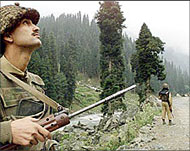Kashmir: another war against drugs
Parvez Ahmad’s exasperation is patent. He has just watched his cannabis crop destroyed by Indian narcotics agents and he cannot understand why, especially since, by his own admission, he ‘fills’ the pockets of the local police.

Ahmad, a farmer in the Himalayan state of Kashmir, says he grows cannabis because irrigation in the area is not good.
“I can’t use my land to grow rice like farmers in the neighbouring villages do,” he complains.
However, Ahmad’s pleas have fallen on deaf ears.
He and numerous other farmers like him in the states of Kashmir, Himachal Pradesh, Uttranchal, and Arunchal Pradesh in the northeast have been the targets of a major anti-drug drive in which thousands of hectares of cannabis and poppy crops have been destroyed. The poppy blossom is used to make opium.
Statistics provided by the India’s narcotics department suggest that narcotic crops such as the hemp, poppy and cannabis worth $55 million have already been flattened, and the campaign goes on, despite the complaints of villagers who claim to have lost their only source of livelihood.
Drug route
Officials in Srinagar, capital of the Indian-administered part of Kashmir, say that every year thousands of kilograms of charas (hashish) are smuggled out of the valley to the Indian plains particularly Maharashtra and Goa in the southwest.
The assistant commissioner of the Customs Department, Verendra Prabhakar, said the cannabis crop destroyed during the first phase of the campaign would have yielded 42,335kg of the drug.
|
Kashmiri officials say that every year thousands of kilograms of charas (hashish) are smuggled out of the valley to the Indian plains. |
Prabhakar’s staff worked day and night to destroy the narcotic crops spread over an area of 682 hectares in about a dozen villages of southern Ananatnag and Pulwama districts.
The soldiers of India’s counter-insurgency Rashtriya Rifles and paramilitary and police forces were on hand to ensure workers were not attacked during the 11-day campaign.
Prior to launching the campaign, Prabhakar said the southern part of Kashmir was the main source of narcotic production in the disputed Himalayan state.
He said 24 villages were identified where cannabis was being cultivated over some 2500 hectares of land in an organised fashion.
“We’re determined to destroy the entire narcotic crop, come what may,” he said.
Bulldozers were deployed to destroy the crops while gun-wielding soldiers stood guard at a distance. The authorities had anticipated resistance from villagers with vested interests in the crops but, in the event, none materialised.
Local impact
 |
|
Drug smugglers keep paramilitary |
Villager Abd al-Karim Kawa, on his way to a mosque to offer Friday prayers said, “I’m quite happy.” He added that cannabis and other narcotic crops cultivation was, no doubt, unlawful but “we as Muslim have to see that Islam has rejected such an activity as a ‘big sin’.”
Kawa also spoke of the impact of drugs on the local community.
“Many of our young boys have become drug addicts, and this has ruined their lives.” The villager said cannabis cultivation could not be discouraged in the past mainly because of the questionable behaviour of the local police.
“They accept bribes and turn a blind eye to this menace,” said Kawa. Another villager said the police receive a ‘’commission’’ from the cannabis cultivators; hence more and more land has been brought under cultivation.
In Maharashtra and neighbouring Goa, quality cannabis is being sold at up to $1750 a kilogram.
“We have authentic reports that the hashish produced in Kashmir is not only sold in markets in Maharashtra, Goa and Gujarat but also sent abroad,” said Prabhakar.
He alleged that the narcotics are smuggled generally packed in apple boxes. In international markets, a kilogram of quality hashish is sold at around $55,000.
Under Indian law, the cultivation of cannabis or any other narcotic crop is prohibited under Section Eight of Narcotic Drugs and Psychotropic Substances Act, 1985 and is punishable with imprisonment for a period ranging from 10 to 20 years and a fine of up to $4500.
Difficulties
|
“We don’t have any source of income. It was only through the cultivation of bhang (cannabis) that we earn a livelihood” Budhi Ram, |
For the moment, the villagers cultivating the illegal crops are likely to escape legal action. Officials say there are tens of thousands of people involved in the illicit trade and prosecuting them will not be an easy task. They would like the villagers to be educated on the consequences of their activities.
Officials in Shimla, the capital of Himachal Pradesh, admit that over the last decade the local economy had been entirely dependent on hashish cultivation.
“We don’t have any source of income. It was only through the cultivation of bhang (cannabis) that we earn a livelihood. I want a piece of land where crops can be grown. We hardly have any land in the area. How will we live?” one Budhi Ram was quoted by Indian newspapers recently.
Himachal Pradesh has become the focal point for drug dealers and thousands of foreign tourists are attracted by the easy availability of hashish and opium in capital Shimla and neighbouring valleys and hill resorts.
Alarmed by the situation, the narcotics bureau started monitoring the rampant trade a few years ago and the Customs Department opened up a special station in Kullu to gauge the seriousness of the problem.
The Indian economy has been growing at record rates over the past few years, but it seems, the benefits have yet to reach the people at the foothills of the Himalayas.